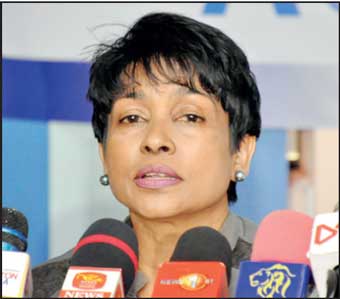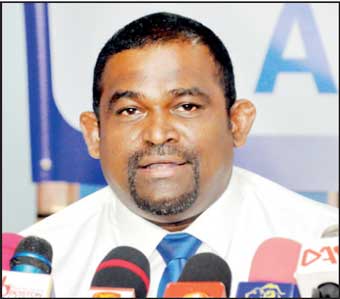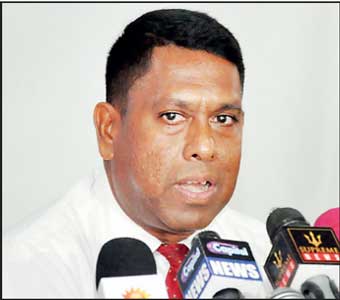Domestic aviation faces turbulence
Wednesday, 22 January 2025 00:00 – – 664
- Aircraft Owners and Operators Association warns of collapse amid unresolved safety concerns and regulatory failures
- Points to high operational costs faced by domestic aviation sector, with tickets making SL less competitive
- Reveals return air ticket from Colombo to Sigiriya is as expensive as return flight to Singapore
- Criticises CAASL for incompetence, corruption and employing unlicensed, inexperienced inspectors
- Discloses CAASL’s failure to address findings from 2018 ICAO Audit report and 2023 OPA report which called for aligning aviation regulations with international standards
- Insists Rathmalana Airport’s boundary wall violates ICAO standards posing safety risks
- Says flight training schools suffer from declining demand due to unnecessary regulations and face closure despite potential for foreign exchange earnings
By Charumini de Silva
 |
| AOAOA Treasurer Nihara Jayatilleke |
 |
| AOAOA President Samith Abeygunawardana |
 |
| AOAOA Secretary Capt. Kosala Fernando |
A scathing critique by the Aircraft Owners and Operators Association (AOAOA) yesterday, detailed the severe crisis the domestic aviation industry faces due to a combination of unresolved safety concerns, regulatory shortcomings, and systemic inefficiencies.
Addressing the media AOAOA Treasurer Nihara Jayatilleke outlined the pressing issues plaguing the sector warning of dire consequences if immediate corrective action by authorities is not taken.
“Sri Lanka’s aviation industry with its 100 years legacy should be a cornerstone of the country’s tourism-driven economy. Instead it is on the brink of collapse,” she said.
Jayatilleke opined that the country must look to the Maldives, which once learnt everything from Sri Lanka has developed its aviation industry to a vibrant sector and has transformed its tourism industry and contributed to the economic growth actively.
“The tourism industry, which relies heavily on domestic aviation to connect high-end travellers to key destinations, is feeling the ripple effects. A return air ticket from Colombo to Sigiriya for example is as expensive as a return flight to Singapore. This makes Sri Lanka less appealing compared to regional competitors like the Maldives, where domestic aviation thrives with over 350 aircraft,” she explained.
She said the AOAOA on 12 December 2024 met with the Sri Lanka Tourism Chairman Buddhika Hewawasam and reportedly expressed concerns about the lack of affordable domestic aviation operations, which are crucial for attracting niche markets.
She claimed that this is a result of incompetence, lack of knowledge and inability of the authority to provide leadership, guidance and unqualified inspectors at the regulatory body – Civil Aviation Authority of Sri Lanka (CAASL).
“Incompetence breeds inefficiency and corruption increases operating costs, which eventually make Sri Lanka uncompetitive and unable to service high-end tourists – another lost opportunity for aviation, tourism, and overall economy,” she said.
Noting that AOAOA has developed a proposal to develop the domestic aviation industry, she said the association is keen on making a comprehensive presentation to the President Anura Kumar Dissanayake at the upcoming meeting.
Jayatilleke also highlighted the grounding of private aircraft and the lack of progress on infrastructure projects such as a planned aircraft engine overhaul facility, as further evidence of the industry’s stagnation.
“The domestic aviation fleet which comprises about 30 aircraft suffered for two years being grounded in 2022, as the CAASL was unable to draft aircraft liability insurance requirements and was ‘foot dragging’ as stated in the International Civil Aviation Organisation (ICAO).
She said in the ICAO report, it stated that the CAASL had cut and pasted “word for word”, of international insurance liability requirements, which was prohibitive and impractical to domestic operators which grounded the entire local operators fleet of aircraft and drove the cost of tickets upwards.
“Stringent application of uniform rules across all categories of aviation is impractical,” she said.
Another key concern raised was the concrete boundary wall at the Galle Road end of Colombo International Airport in Rathmalana. The wall initially constructed in 2006/07 has been criticised for violating International Civil Aviation Organisation (ICAO) standards.
She cited the December 2024, Jeju aircraft crash in South Korea, where a similar wall contributed to the deaths of 179 passengers, as a stark reminder of the dangers posed by such a structure.
Despite the repeated appeals from the AOAOA and a Ministerial directive to replace the wall with a frangible fence, the CAASL has yet to act, reflecting what the association described as “professional incompetence and a lack of accountability”.
Jayatilleke argued that the lack of a similar wall at the Bandaranaike International Airport (BIA) in Katunayake was the reason for the 2001 attack by the terrorists, noting that both BIA and the Mattala International Airport have no walls, but frangible fences.
The AOAOA President Samith Abeygunawardena also raised broader issues regarding regulatory oversight and operational inefficiencies within CAASL. He accused the regulator of employing unlicensed and inexperienced inspectors who lack the expertise to oversee critical aspects of aircraft maintenance and operations.
“At present, CAASL Inspectors responsible for the compliance of airworthiness and flight operations of the aircraft are ‘not licenced or experienced. However, they continue to instruct the licenced professional of the operators and are entirely unfamiliar with maintenance and pilot operating techniques which are permitted by the manufacturer or industrial best practices. This has created a counterproductive dynamic, where operators are forced to educate regulators, leading to increased costs and inefficiencies,” he elaborated.
Abeygunawardena said the minimum expectations the operators have of the CAASL is to have licenced engineers or pilots with industrial experience.
The AOAOA also pointed out that the domestic aviation industry’s troubles are compounded by the CAASL’s failure to address findings from key reports, including ICAO Universal Safety Oversight Audit Program (USOAP) of 2018 and a 2023 report titled ‘The role of domestic aviation in Sri Lankan Tourism’ by the Organisation of Professional Association (OPA) . Both of these documents according to AOAOA highlighted significant regulatory and operational gaps, although the issues remain unresolved.
The ICAO audit called for a structured review of Sri Lanka’s aviation regulations to align them with international standards, while the OPA report criticised the regulatory bodies for being obstructive rather than facilitative.
“Both of these reports have been disregarded by the current and previous CAASL Director General, even after emphasis by the AOAOA,” Abeygunawardena said.
He said the AOAOA personally handed the copies of these two vital reports on 11 December 2024, to the Ports Shipping Transport and Civil Aviation Ministry Secretary, but it appears there is still no update of such oversight brought to the notice of the Minister, thus dragging the industry closer to collapse.
Against this backdrop, the AOAOA urged the Ports, Shipping, Transport and Civil Aviation Minister to take immediate action to address the sector’s challenges, cautioning the failure to do so could result in the withdrawal of investments, the collapse of the domestic aviation industry and long-term economic repercussions.
“Without decisive action, Sri Lanka risks a future where its airports fall silent and the opportunities for growth and development in the aviation industry are permanently lost,” he said.
AOAOA Secretary Capt. Kosala Fernando said the oversight by the CAASL has elevated the flight training expenses, slashing the demand and foreign exchange income the industry could have easily generated to the economy.
“Eight years ago, flying schools experienced high demand with around 40 students enrolling per program annually each paying Rs. 15 million. Students from countries like India, Maldives and Indonesia participated in these programs but the requirement for a three month wait for security clearance through Interpol deterred many, as this process was deemed unnecessary. In contrast the Maldives has implemented more favourable regulations to support such programs,” he said, revealing that some of the flying schools are at the verge of closure.
He also criticised the delays by the CAASL in processing licence holder endorsements with some individuals reportedly taking their grievances to the CID and Bribery Commission.
In addition, he said the Colombo Flying Club — a recreational aviation organisation has been grounded due to regulations requiring private aircraft to meet the same maintenance standards as commercial aircraft. This policy has hindered leisure flying unaffordable and impractical, effectively side-lining the club’s operations.
“The CAASL is just maintaining the regulations as it is. This one-size-fits-all approach by the regulator is unrealistic and suppress private aviation,” Capt. Fernando said.
Jayatilleke highlighted another issue, where Sri Lanka Custom’s inability to differentiate between aircraft tires and motor vehicle tires. “Aircraft tires which qualify for duty-free or concessional rates are at times incorrectly classified under higher-duty categories meant for motor vehicles. Despite the CAASL being informed of this issue in July 2020, no action was taken to rectify the situation. This oversight has prevented the aviation industry from enjoying legitimate cost advantages leading to higher ticket prices for domestic passengers, increased operational costs and flight training expenses. The latter in particular is deterrent for foreign students reducing Sri Lanka’s appeal as an aviation training hub for the region,” she said.
Jayatilleke said proposals for simplified spare parts import process have been repeatedly ignored by the regulator and authorities further frustrating stakeholders.





